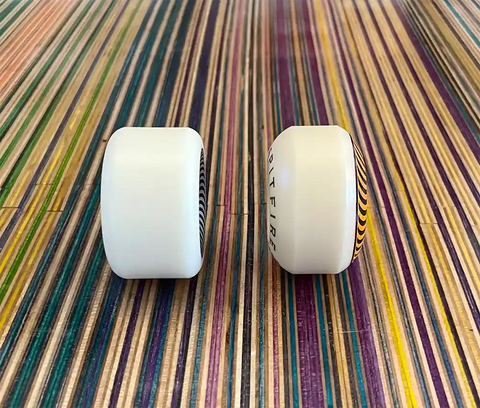Skateboard wheel shapes in comparison
In the following article we will take a closer look at the different features, advantages and disadvantages of different skateboard wheel shapes and get to the bottom of the question of how narrow wheels affect the handling of your skateboard compared to wide wheels.

Classic round skateboard wheels:
This shape of Wheels has been the standard shape for the last 20 years.
Round wheels are usually a bit narrower . Such roles are usually somewhat lighter as a result. We compared the different shapes of different brands and came to the conclusion that there is a difference of around 10% between the widest and narrowest wheels from different manufacturers. With Spitfire, for example, the difference in weight between a fairly wide lock-in reel and the classics is around 8%. However, you shouldn't overestimate this because the actual difference is only 20 grams.
The smaller width of such wheels also means that the wheels usually have a narrow tread. This leads to less frictional resistance when driving and, in theory, to higher speeds. The resistance in slides of any kind where the wheels touch a surface, i.e. nose slides, tail slides and blunt slides, but also in power slides on the ground, the coefficient of friction is lower, i.e. these wheels slide better .
However, because less material is used here, narrow wheels wear faster and are also more susceptible to “flat spots”. Flat spots are edges that can occur during slides when too much material on the roll is rubbed off due to the transverse position of the wheels, creating a flat spot on the running surface of the roll, which means that it is no longer completely round.
An aspect that is often ignored: Narrower and rounded wheels reduce the distance between the contact point and the ground. This makes your board more agile and easier to turn when doing flip tricks. The round edge of the roller also ensures that flip tricks in which the board rotates around the transverse axis, such as 360 flips or varial flips, are easier.
There are also differences in grinds :
Narrower wheels widen the grinding surface of your trucks.
With Slappy Grinds, the round side surface of the roll makes it easier to get into the grind.
For special grinds such as Crooked, Smith or Feeble Grinds, where the roller is in contact with the edge of the ledge or rail in an inclined position, a round roller offers less frictional resistance due to the less sharp edge, resulting in easier, longer grinds leads.
Wider wheels:
These are usually cut conically on the inside, but can also have round edges, such as the Spitfire Radial Fulls.
The advantages and disadvantages of wider rollers are largely derived from those of narrow rollers. Wider wheels have a longer lifespan and are not as susceptible to flat spots.
The wider tread gives you more grip and control at high speeds, especially on rough surfaces.
“Luring” into grinds is easier with conical wheels. Thanks to the smoother inner edge compared to a round roller, you are more stable in grinds and don't slip over the edge as easily. This is particularly relevant for round curbs and ledges, or for ramp coping.
The graphic print on your wheels also lasts longer with conical wheels because the design is protected by the outer edges of the wheels and is not on the outside like with round wheels.
However, wide wheels also widen your wheelbase, which affects agility and, due to the usually smaller radius of the outer edge, also influences the reaction during flip tricks.
In this article, we have looked at all the details of Skateboard Wheels. Please don't be confused, the differences in driving behavior are often minimal and are usually only relevant for very advanced skateboarders.
You can find our large skateboard wheel selection here:


